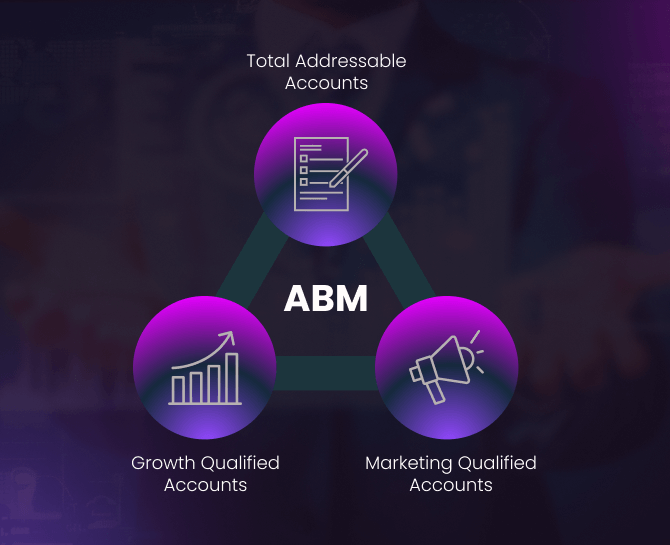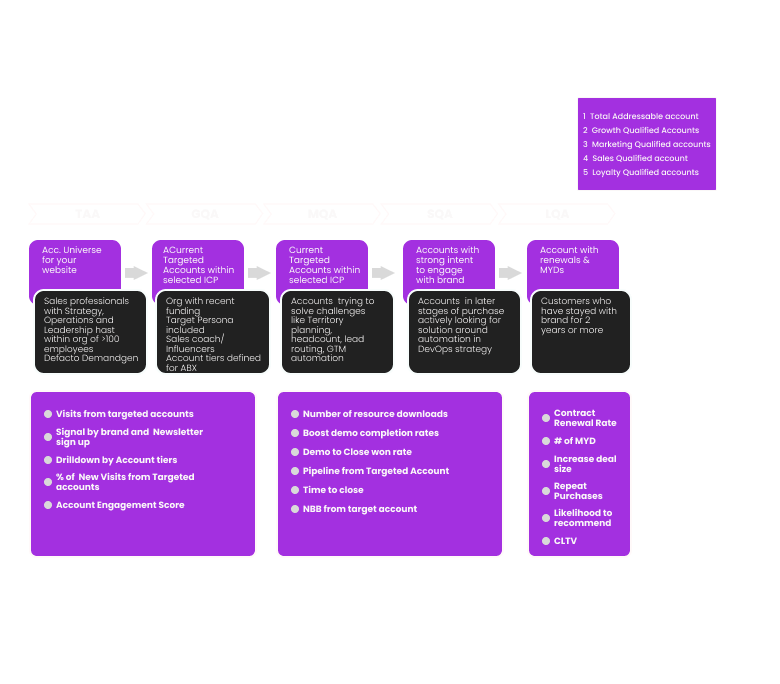
Account-Based Marketing Framework: Drive Targeted Success
Businesses often grapple with the challenges of traditional, broad-stroke marketing strategies that fail to deliver the precision needed for success. The need for a strategic shift becomes apparent as companies seek a more targeted and impactful approach. This blog post is a comprehensive guide for businesses to navigate the complexities of ABM successfully.
As a marketer, we’re sure that at some point or another, you’ve considered trading in the old marketing playbook for a shiny new one. A strategy that’s not just about casting a wide net and crossing your fingers. Enter – Account-Based Marketing!
ABM isn’t just a strategy, it’s a mindset shift that’s reshaping the game. It’s about precision over scattergun approaches, targeting high-value accounts with surgical precision.
In a world saturated with information, businesses are realizing the need for a more personalized, one-on-one approach. ABM offers just that, fostering a deep understanding of individual accounts and tailoring strategies to meet their specific needs.
And what you need for that is a comprehensive ABM framework that is poised to transform high-value accounts into loyal partners. Let’s explore all there is to it, shall we?
Why ABM?
ABM isn’t your regular, run-of-the-mill marketing strategy. Instead of shouting into the abyss, you’re having a one-on-one conversation with your dream clients.
ABM is a strategy where sales and marketing teams work hand-in-hand, a synchronized symphony of efforts. It’s not just about generating leads, it’s about cultivating meaningful relationships that stand the test of time, increasing conversion rates, and ultimately driving revenue.
The beauty of ABM lies in its data-driven Sherlock-like approach. Data is its secret weapon. Dive into customer behaviors, preferences, and engagement patterns. It’s not stalking, it’s strategic intel that lets you tailor your approach with precision.
ABM also turns you into a storytelling maestro, crafting personalized narratives that resonate with your target accounts. It’s not just about catchy taglines, it’s about creating a compelling story between your brand and theirs.
Creating a Comprehensive Account-Based Marketing Framework
At its core, ABM is a personalized approach that flips the traditional marketing funnel on its head. It’s all about identifying high-value accounts, building buyer personas, orchestrating multi-channel campaigns, and data-driven decision-making. All these elements make for a well-defined ABM framework that transforms marketing from a broad-strokes approach into a targeted masterpiece.
Here’s all you would need to factor in while creating an all-encompassing ABM framework that drives true revenue:
- The Account Stages in an ABM Framework:
- Total Addressable Accounts (TAA):
- Growth Qualified Accounts (GQA):
- Marketing Qualified Accounts (MQA):
- Sales Qualified Accounts (SQA):
- Loyalty Qualified Accounts (LQA):
- Tailored Content for Each Stage:
- Content for Total Addressable Accounts (TAA):
- Content for Growth Qualified Accounts (GQA):
- Content for Marketing Qualified Accounts (MQA):
- Content for Sales Qualified Accounts (SQA):
- Content for Loyalty Qualified Accounts (LQA):
- Multi-Channel Engagement:
- Display Ads:
- Retargeting:
- Video/YouTube Ads:
- Social Media:
- SEO (Search Engine Optimization):
- Email:
- Measurable KPIs for Each Account Stage:
- KPIs for the Total Addressable Accounts (TAA) Stage:
- KPIs for the Growth Qualified Accounts (GQA) Stage:
- KPIs for the Marketing Qualified Accounts (MQA) Stage:
- KPIs for the Sales Qualified Accounts (SQA) Stage:
- KPIs for the Loyalty Qualified Accounts (LQA) Stage:
- Throughout the ABM Journey:
The account stages in an ABM framework provide a structured approach, guiding businesses from identifying potential targets to nurturing long-term, loyal relationships. It’s a pragmatic progression that aligns marketing efforts with the evolving status of target accounts. Here are the stages:

At the heart of any ABM framework is the identification of the Total Addressable Accounts. These are the accounts that fit the ideal customer profile and constitute the entire universe of potential targets. It’s the first step in narrowing down the field. The goal is to define the accounts that are worth focusing on, streamlining efforts for efficiency.
The next stage is all about identifying accounts showing potential for expansion and development. Growth Qualified Accounts (GQA) are those that exhibit signs of scalability and increased engagement. This stage involves a careful analysis of account behaviors and patterns that signal a readiness for the next level.
In this stage, Marketing Qualified Accounts (MQA) take center stage. These are the leads that have shown interest and are deemed marketing-qualified. It’s not just about the numbers here, it’s about the quality of engagement. MQAs represent accounts that have interacted meaningfully with your brand. The emphasis is on the quality of engagement, distinguishing leads that are more likely to convert.
Stepping into the Sales Qualified Accounts (SQA) stage, we pinpoint accounts that are not just interested but are sales-ready. The focus here is on accounts that have moved beyond the marketing funnel and are poised for direct sales engagement. It’s the moment of truth where the marketing and sales collaboration truly shines.
In the grand finale, we have the Loyalty Qualified Accounts (LQA). This stage recognizes accounts that have not only made a purchase but have gone the extra mile, giving testimonials or referrals. Existing customers in the LQA stage become gems to be nurtured for upselling or cross-selling, contributing to a sustainable, long-term relationship.
Tailored content plays a pivotal role in an ABM framework. Let’s break down the importance of customized content tailored to the specific needs of each stage, turning the gears of engagement and conversion.
At the TAA stage, the focus is on defining the universe of potential target accounts. Tailored content comes into play by creating awareness and introducing these accounts to your brand. It’s about delivering content that resonates with the overarching characteristics of your ideal customers, laying the foundation for future engagement.
As accounts show signs of growth potential, tailored content becomes a compass for nurturing this expansion. It’s not about generic messages but delivering content that speaks directly to the scalability and development these accounts are seeking. Whether it’s case studies or industry-specific insights, the content absolutely must align with their growth trajectory.
MQAs have shown genuine interest, and now it’s about deepening that connection. Tailored content here takes the form of in-depth resources, product demonstrations, or targeted webinars. It’s about delivering content that aligns with their specific interests and needs, pushing them further down the funnel.
In the SQA stage, where accounts are sales-ready, tailored content becomes the secret sauce for conversion. This is the time for personalized proposals, one-on-one consultations, and content that directly addresses their pain points. It’s about demonstrating how your solution is the answer they’ve been looking for.
As accounts achieve loyalty status, the content strategy shifts towards nurturing and retaining these valuable relationships. It could involve exclusive offers, loyalty programs, or content that showcases the continued value your product or service brings. It’s about maintaining engagement and providing content that aligns with their evolving needs.
The beauty of a multi-channel engagement model lies in its ability to meet potential clients where they are. It acknowledges that each account is unique, and their preferred channels for information consumption vary. By utilizing a mix of channels, businesses increase the touchpoints, ensuring a more comprehensive and impactful interaction.
It’s not just about being present on various platforms, it’s about orchestrating a seamless, immersive experience that guides target accounts through the different stages of the ABM journey. Here are the various channels and the roles they play across ABM stages:
TAA Stage: Ideal for creating brand awareness and introducing potential target accounts to your offerings.
GQA Stage: Tailor display ads to highlight scalability and growth potential.
GQA and MQA Stages: Remind prospects of your value proposition and nurture them with relevant content based on their previous interactions.
SEM (Search Engine Marketing):
TAA and GQA Stages: Boost visibility for potential target accounts actively searching for solutions in your domain.
TAA and GQA Stages: Engage potential accounts with visually compelling content, introducing your brand and showcasing growth possibilities.
All Stages: Utilize social platforms for brand exposure, sharing industry insights, and fostering engagement. Tailor content to align with the specific interests of each account.
TAA Stage: Optimize content to ensure your brand is discoverable when potential accounts start their research.
MQA, SQA, and LQA Stages: A versatile channel that evolves with the ABM journey – from delivering targeted content to conversion-focused emails, and later, nurturing loyalty through exclusive offers.
Effectively measuring Key Performance Indicators (KPIs) at each account stage is crucial for refining and optimizing an ABM strategy. Measurement isn’t an afterthought in an ABM strategy, it’s a continuous, integral process. Let’s break down these measurable KPIs and align them with their respective stages in the ABM framework.

Visits from Targeted Accounts: Track the number of visits from identified target accounts to gauge initial awareness and interest.
Signal by Brand and Newsletter Sign-Up: Measure brand recognition and interest by monitoring signals such as newsletter sign-ups from TAA.
Drill-down by Account Tiers: Understand the hierarchy and distribution of accounts within tiers to identify high-potential areas for growth.
Percentage of New Visits from Targeted Accounts: Evaluate the proportion of new visits from targeted accounts to assess expanding reach.
Account Engagement Score: Develop an engagement score to quantify the level of interaction and interest from MQAs.
Number of Resource Downloads: Track the number of downloads to measure the relevance and usefulness of provided resources.
Demo to Closed Won Rate: Measure the effectiveness of demos by tracking the conversion rate from demo to closed-won deals.
Pipeline from Targeted Accounts: Assess the health and potential revenue from the pipeline generated from SQA.
Time to Close: Evaluate the time taken to close deals for LQA, providing insights into efficiency and effectiveness.
Contract Renewal Rate: Measure the percentage of contract renewals to assess customer satisfaction and loyalty.
Number of Marketing-Qualified Deals (MYD): Track the number of deals that meet marketing criteria to assess the quality of leads generated.
Increase in Deal Size: Measure the growth in deal size over time to understand the impact of ABM on deal value.
Repeat Purchases: Monitor the frequency of repeat purchases to gauge customer loyalty and satisfaction.
Likelihood to Recommend: Assess the likelihood of accounts recommending your product or service as an indicator of overall satisfaction.
Customer Lifetime Value (CLTV): Calculate the CLTV to understand the long-term value and profitability of each customer.
Wrapping Up
ABM is not merely a strategy but a revolutionary approach to customer engagement where every element – from email and social media to personalized ads and beyond – plays a vital role in creating a seamless experience for high-value accounts.
It’s important, however, to remember that ABM is not a static strategy, it’s an iterative process where insights gleaned from data drive continuous improvement. It’s a commitment to rewriting the rules, navigating the complex landscape of B2B marketing with agility, and ultimately achieving success in a world that demands innovation and adaptability. The time to get cracking on your ABM framework is now!
Wish to Unlock Success With a Comprehensive ABM Framework? Talk to Us!
We would love to meet you wherever you are in your ABM journey. Just write to us at info@diggrowth.com and we’ll get back to you.
Ready to get started?
Increase your marketing ROI by 30% with custom dashboards & reports that present a clear picture of marketing effectiveness
Start Free Trial
Experience Premium Marketing Analytics At Budget-Friendly Pricing.

Learn how you can accurately measure return on marketing investment.
Additional Resources
How Predictive AI Will Transform Paid Media Strategy in 2026
Paid media isn’t a channel game anymore, it’s...
Read full post postDon’t Let AI Break Your Brand: What Every CMO Should Know
AI isn’t just another marketing tool. It’s changing...
Read full post postFrom Demos to Deployment: Why MCP Is the Foundation of Agentic AI
A quiet revolution is unfolding in AI. And...
Read full post post

